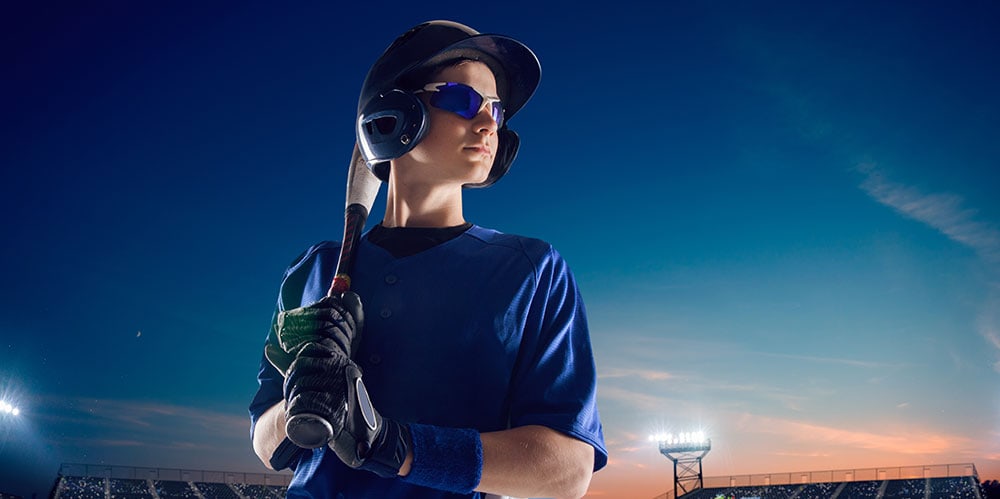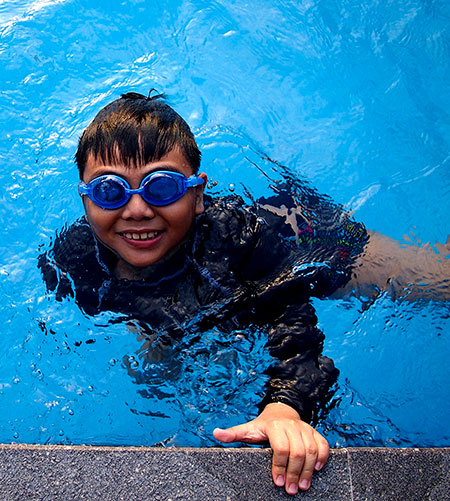Of the 30,000 sports eye injuries treated in emergency rooms annually, roughly 90% could be prevented by wearing sports eyewear protection. Worryingly, many Americans are unaware of the danger of eye injury when playing sports, even though sports injuries are a leading cause of blindness in children in the U.S., according to the National Eye Institute.

What is protective eyewear for sports?
Protective eyewear is usually made from ultra-strong polycarbonate, an impact-resistant, shatterproof plastic that can also incorporate UV protection, sheltering your eyes from harmful ultraviolet light. The best kids’ sports glasses come with an adjustable strap and nose pads, allowing them to be molded to fit the face shape.
Eye protection includes safety goggles and eyewear designed for specific sports, such as swimming goggles, eye protection for racquet sports, or baseball protective glasses. Ensuring your child wears eye protection makes sports such as these much safer. However, ensure the eye protection glasses for sports you choose conform to ASTM F803 standards to give them the best protection possible.
Prescription eyeglasses or sunglasses are not enough to protect kids from eye injuries. However, you can buy prescription youth sports eyeglasses or use safety goggles over regular prescription eyewear.
Sports eyeglasses should be worn when playing basketball (the largest source of eye injuries), volleyball, racquetball, and baseball. Football, lacrosse, boxing, and soccer are other sports that have potential for eye injury.
Sports-related eye injuries
Although some eye injuries can seem minor, having your child examined by an ophthalmologist if they do suffer one is best. Symptoms of a potentially severe eye injury include pain, swelling or bruising of the eyelid, cuts on the eyelid or brow, sensitivity to light, eye immobility, vision impairment (including dark spots, blind spots, floaters or flashing lights), and double, blurred, or lost vision.
Below are some of the more common sporting eye injuries:
Corneal abrasion
The cornea is the transparent membrane that covers the iris and pupil. A foreign body, such as a grain of sand, getting between it and the eyelid and scratching it can be painful and lead to light sensitivity, although it’s rarely serious.

Hyphema
Hyphena is when blood covers part or all of the iris and the pupil, partly or entirely blocking vision, and is usually the result of the eye being struck. This condition is considered severe, and you should seek immediate medical advice if you notice blood in your child’s eye.
Black eye
One of the most common eye injuries, a black eye is the bruising around the eye that results from being struck. The pain and swelling can be reduced by placing an ice pack on the eye, but it may take several weeks to heal.
Bone fracture
Fracturing the bones around the eye can cause severe damage to the eye itself. If you suspect your child has a fracture, consult our ophthalmologist immediately.
Eyelid laceration
Although a cut on the eyelid can seem minor, what caused it may also have damaged the eye. As with all injuries to or around the eye, it’s best to have your child examined by an ophthalmologist.
Selecting the correct sports eye protection glasses
It’s important to note that a helmet alone will not protect your child’s eyes from impact injuries. While baseball or softball are played using protective headgear, it often lacks eye protection. If your child’s team doesn’t provide a suitable helmet, you can buy one from a sporting goods store or online retailer.
Lacrosse, another popular sport, should always be played in a helmet with a full-face mask. Interestingly, lacrosse helmets for girls have less eye protection than those for boys. Your daughter’s lacrosse team may require players to wear a helmet with an eye guard; however, a full-face mask is best.
When picking sports eyewear, make sure it meets ANSI Z87.1 standards. These standards guarantee the protective wear provides sufficient high-velocity and impact resistance. We recommend lenses with anti-fog and scratch-resistant coatings to ensure clear vision.
Most sports sunglasses have a selection of tints and can be prescription or non-prescription. Brands like Maxx, Nike, Wiley X, Helmet Spex, and Oakley have kids’ sunglasses and sports glasses.
Safety glasses, sports sunglasses, and sports eye protection goggles come in two general categories:
- Sports glasses: These are effective for low-intensity kids’ sports with little contact between players.
- Sports goggles: These maintain contact with the face better than sports glasses, so they’re recommended for high-intensity sports with a higher chance of contact.
Our ophthalmologists can advise you about kids’ prescription sports glasses if your child wears eyewear for vision correction. Options can include prescription sports goggles, prescription sunglasses, and glasses with prescription lenses.
For your child’s safety, make sure their sports eyewear fits properly. Poor-fitting eye protection may not protect your child from injury and could do more harm than good. Sports eyewear should fit securely but not too tight, ensuring the cage or shield does not hinder the young athlete’s vision.
Why trust Assil Gaur Eye Institute with your child’s eyes?
At Assil Gaur Eye Institute (AGEI), you will experience state-of-the-art ophthalmology that combines revolutionary technologies with experienced, board-certified vision care professionals. We aim to help you achieve your best vision and eye health.
If you are experiencing any concerning symptoms or require immediate eye care, contact us to determine the best time to schedule an exam. Please call 866-945-2745 or make an appointment online.
We are conveniently located for patients throughout Southern California and the Los Angeles area in or near Beverly Hills, Santa Monica, West Los Angeles, West Hollywood, Culver City, Hollywood, Venice, Marina del Rey, Malibu, Manhattan Beach, and Downtown Los Angeles.














